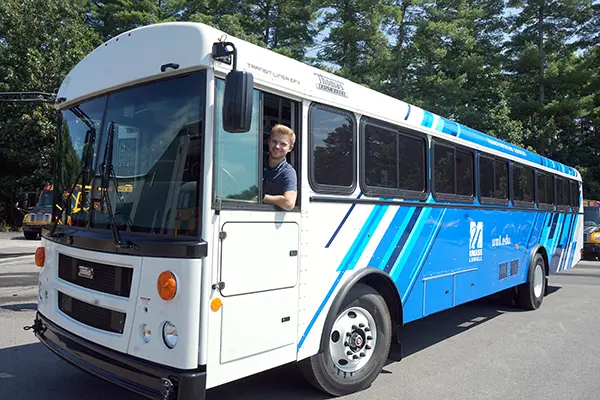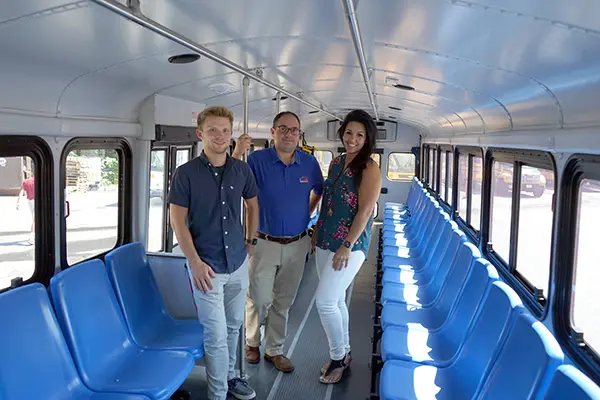ADA-Compliant Fleet Features Ridership Tracking Technology, Modern Design
 Image by Ed Brennen
Image by Ed Brennen
Transportation Operations Manager Nathan Klosowski gets behind the wheel of one of the new buses that will get River Hawks around campus starting this fall.
08/31/2022
By Ed Brennen
Transportation Services is rolling out eight brand-new 60-passenger buses to replace a fleet that had been in service at UML for more than a decade. The buses are part of the university’s new contract with Beacon Mobility (formerly NRT Bus), a national network of transportation companies that owns and maintains the buses and provides drivers.
The new buses feature a more modern exterior design, with blue, angled slashes on a white background creating a sense of motion — an effect that Transportation Operations Manager Nathan Klosowski ’20 says he was going for when collaborating with designers from UML’s Office of University Relations on the wraps.
Passengers will also notice new audio announcements alerting them to stops, in addition to interior and exterior destination signage.
“We’re excited for students to start riding the new buses,” says Executive Director of Administrative Services Nicholas Piscitello, who notes that the audio announcements “will make the ridership experience similar to that of a public transit agency.”
Each bus is equipped with a wheelchair lift, as well as four forward-facing seats at the front, making them fully compliant with the Americans with Disabilities Act (ADA). The remaining passenger seats are sideways-facing, similar to subway cars, which creates more room for riders who choose to stand.
 Image by Ed Brennen
Image by Ed Brennen
Transportation Operations Manager Nathan Klosowski, left, Executive Director of Administrative Services Nicholas Piscitello and Transportation Asst. Director Karina Cruz check out the interior of a new bus.
One new technological twist that riders won’t notice, but that Transportation Services is excited about, is automatic passenger counters on the front and rear doors. On the old buses, drivers would manually log ridership on an iPad. (Students are required to swipe their UML ID when boarding the smaller shuttle buses.)
“By having a more accurate passenger count, we’re able to better tailor our service to meet demand,” says Transportation Asst. Director Karina Cruz.
This is particularly important coming out of the pandemic, Piscitello adds, since it has been difficult to forecast ridership with students opting to take more online or hybrid courses.
“We really don’t know what to expect this fall for student population and movement around campus,” he says. “That’s our biggest challenge right now.”
Last year, the Blue Line (connecting North and South campus via University Crossing) and the Red Line (connecting East and South campus) each averaged around 2,000 riders per weekday, which was down “significantly” compared to 2019, Piscitello says.
Unfortunately, because of pandemic-related supply chain issues, only two of the eight new buses will be ready for the start of the academic year. The remaining six buses are expected to be added over the course of the semester, Cruz says. Until then, Beacon Mobility will continue to operate some of the university’s older buses.
While the new buses still run on diesel fuel, their engines are more fuel-efficient than the 2010 models. Beacon Mobility is exploring ways to convert a majority of its buses to electric or alternative fuel by 2035, Piscitello says, and the university is in talks with them to convert its buses to electric in the next “five to 10 years.”
The recent completion of two canal bridges on Pawtucket Street has allowed UML buses to take more direct routes, reducing their emissions and creating a “more seamless connection between campuses,” Piscitello says.
“When the weather is nice, we want people to use multiple modes of transportation, whether that’s walking, biking or using shuttle services,” he says. “It’s all about getting those single-occupancy vehicles off the road and not having people feel like they have to drive between campuses.”
